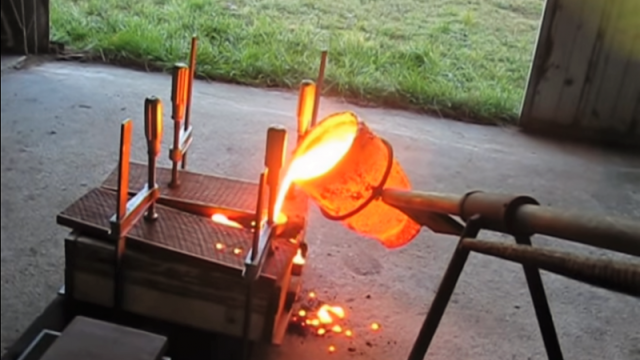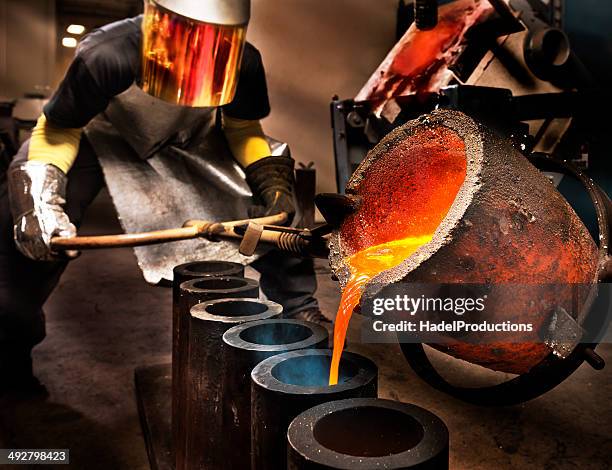Key Reasons to Choose a Metal Foundry for Specialized Projects
Wiki Article
Recognizing Metal Casting Procedures: Advancements and Trends in the Foundry Sector
The foundry market is experiencing significant transformations driven by technical improvements. Advancements such as 3D printing and synthetic intelligence are improving steel casting processes, enhancing efficiency and precision. Lasting methods are gaining traction, emphasizing the importance of environmental responsibility. In addition, the introduction of sophisticated materials and automation is enhancing overall casting top quality. These advancements suggest a pivotal change in the industry, questioning concerning future instructions and implications for producers.Developments in 3D Printing for Metal Casting
Recent innovations in 3D printing modern technology have substantially transformed the landscape of metal casting. The integration of additive production strategies has enabled the fast manufacturing of complicated patterns and molds that were previously challenging or impossible to accomplish with conventional methods. By using products such as sand and steel powders, producers can create elaborate geometries that boost style flexibility and decrease product waste. This innovation not just expedites the prototyping process yet likewise permits the modification of components customized to details applications.
Additionally, 3D printing promotes much shorter lead times, which is important in industries calling for quick turn-around for components. The modern technology likewise sustains the production of light-weight frameworks, thereby boosting energy performance in end products. Therefore, the foundry market is observing a shift in the direction of more lasting techniques, driven by the performance and precision provided by these modern-day 3D printing methods in steel casting procedures.
The Role of Expert System in Precision Production
As industries increasingly adopt innovative production technologies, man-made intelligence (AI) is playing a crucial role in boosting precision production procedures. AI formulas analyze substantial datasets to optimize and identify patterns manufacturing criteria, leading to boosted accuracy and performance. In metal casting, AI aids in anticipating upkeep, decreasing downtime by projecting tools failings before they happen.Additionally, AI-driven simulations make it possible for suppliers to design the casting process, refining designs and lessening flaws. Artificial intelligence strategies improve top quality control by discovering abnormalities in real-time, thereby guaranteeing that just products fulfilling rigorous specifications continue with the production line.

Lasting Practices in the Foundry Industry
Sustainability has actually arised as an essential emphasis in the foundry sector, triggering makers to adopt techniques that minimize ecological influence while preserving performance - Metal Casting. One noticeable technique includes the recycling of materials, especially metals, which substantially minimizes waste and energy usage. Factories are progressively carrying out closed-loop systems, permitting the reuse of sand and various other casting products, thereby decreasing the demand for virgin sourcesAdditionally, energy-efficient innovations, such as electrical heating systems, are obtaining traction, as they lower greenhouse gas emissions contrasted to conventional approaches. Many factories are discovering the use of biodegradable binders and eco-friendly finishings to lower poisonous by-products. Staff member training on lasting techniques has actually likewise come to be important, fostering a culture of environmental obligation within companies. Overall, these lasting practices not only add to ecological conservation yet also boost the long-term stability of the foundry sector in a significantly eco-conscious market.
Technologies in Products for Improved Casting Quality
With the continuous evolution of the foundry industry, developments in materials have come to be important for boosting casting high quality. Advanced alloys and composite products are significantly being utilized to boost mechanical residential or commercial properties and reduce problems in spreadings. These products often provide exceptional strength-to-weight proportions and boosted resistance to corrosion and wear, addressing the needs of modern applications.Furthermore, the unification of nanomaterials is getting traction, enabling for finer microstructures that result in enhanced surface coatings and dimensional accuracy. Aluminum Foundry. 3D printing modern technologies likewise contribute in this content generating intricate geometries with very little waste, making it possible for making use of customized materials that were formerly challenging to cast
The growth of environmentally friendly binders and additives contributes to lasting methods while preserving high-quality outcomes. Jointly, these technologies not only enhance the performance of cast products but likewise straighten with the market's shift towards sustainability and performance.
Automation and Robotics in Metal Casting Processes
Automation and robotics are revolutionizing metal casting processes by improving procedures and improving precision. In modern foundries, robot systems are used for jobs such as mold and mildew handling, pouring, and finishing, considerably lowering human treatment. This not just minimizes the threat of accidents however additionally guarantees constant top quality in production.Automation technologies, such as computer system numerical control (CNC) devices, promote elaborate designs and complicated geometries that were formerly testing to achieve. Real-time data analytics allow manufacturers to monitor procedures and enhance performance constantly.
Check The assimilation of automation brings about increased productivity and performance, permitting foundries to fulfill expanding market demands while decreasing lead times. As the industry embraces these developments, the workforce is also progressing, requiring new abilities to operate and maintain sophisticated machinery. Generally, the fostering of automation and robotics is a crucial fad shaping the future of metal casting processes.
Regularly Asked Questions
What Is the Background of Metal Casting Methods?
Metal casting techniques date back to ancient people, with proof of bronze casting in Mesopotamia around 3000 BCE. Over centuries, methods evolved considerably, incorporating innovations in products and modern technology, shaping contemporary commercial techniques.How Does Metal Casting Influence the Atmosphere?
Metal casting substantially affects the environment with energy consumption, exhausts, and waste generation. Nevertheless, advancements in lasting techniques and modern technologies aim to minimize these effects, advertising even more ecologically pleasant approaches within the sector.What Safety And Security Procedures Are Critical in Factories?

What Prevail Defects in Metal Casting Products?
Usual problems in steel casting products consist of porosity, shrinking, misruns, cool shuts, and surface imperfections. These issues emerge from elements such as incorrect temperature control, insufficient mold design, and contamination click for more during the casting process.How Do Foundries Guarantee High Quality Control in Casting Processes?
Factories execute rigorous quality assurance steps with regular evaluations, standardized testing, procedure surveillance, and adherence to industry criteria. These techniques assist determine flaws early, making sure the stability and dependability of the final casting products.Innovations such as 3D printing and artificial knowledge are improving metal casting processes, enhancing performance and precision. Current improvements in 3D printing innovation have considerably changed the landscape of metal casting. Automation and robotics are transforming steel casting procedures by boosting and enhancing operations precision. Metal casting strategies day back to ancient civilizations, with evidence of bronze casting why not try these out in Mesopotamia around 3000 BCE. Usual flaws in steel casting products include porosity, shrinkage, misruns, cool shuts, and surface area flaws.
Report this wiki page